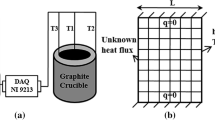Abstract
MgCl2-containing salt is one of the candidates for the solar thermal energy storage applications. To protect the structural alloy from corrosion, the addition of Mg to salt as a corrosion inhibitor is considered. Melting point, heat capacity, enthalpy, entropy and Gibbs energy of MgCl2 with different amount of Mg are studied in this paper. Depression of melting point is calculated using a derivation of Raoul-Van’t Hoff formula. The MgCl2 rich phase diagram is constructed. The MgCl2 with a small amount of Mg addition shows no significant effect on melting point of the salt mixture. Moreover, it can be a candidate as heat transferring fluid for MgCl2 in solar thermal energy storage applications.
Access this chapter
Tax calculation will be finalised at checkout
Purchases are for personal use only
Preview
Unable to display preview. Download preview PDF.
Similar content being viewed by others
References
Y. Takahashi, R. Sakamoto, M. Kamimoto, Heat Capacities and Latent Heat of LiNO3, NaNO3 & KNO3, International Journal of Thermophysics, Vol. 9, 1998. pp. 1081–1090.
Araki, N., et al. “Measurement of thermophysical properties of molten salts: mixtures of alkaline carbonate salts.” International journal of thermophysics Vol. 9, 1988. pp. 1071–1080.
Williams, D. F., Assessment of candidate molten salt coolants for the NGNP/NHI Heat-Transfer Loop, ORNL/TM-2006/69, 2006. pp. 1–44.
Sridharan, Kumar, et al. Liquid Salts as Media for Process Heat Transfer from VHTR’s: Forced Convective Channel Flow Thermal Hydraulics, Materials, and Coating. No. DOE/ID14826. University of Wisconsin, Madison, 2012.
Susskind, H., et al. Corrosion Studies for a Fused Salt-Liquid Metal Extraction Process for the Liquid Metal Fuel Reactor. No. BNL-585. Brookhaven National Lab., Upton, NY, 1960.
Forsberg, Charles W., Per F. Peterson, and Haihua Zhao. “High-temperature liquid-fluoride-salt closed-Brayton-cycle solar power towers.” Journal of Solar Energy Engineering Vol. 129.2, 2007. pp. 141–146.
Sohal, Manohar S., et al. “Engineering database of liquid salt thermophysical and thermochemical properties.” Idaho National Laboratory, Idaho Falls, 2010.
Heine, D., F. Heess, and D. Steiner. “Investigation of latent heat storage materials in the medium and high temperature range.” NASA STI/Recon Technical Report N 83: 16933, 1982.
Sellers, R. S., et al. “Materials corrosion in molten LiF-NaF-KF eutectic salt under different reduction-oxidation conditions.” Proc. Int. Conf. Advances in Nuclear Power Plants. Vol. 12, 2012. pp. 12189.
Li, Xiao-li, et al. “High-temperature corrosion behavior of Ni-16Mo-7Cr-4Fe superalloy containing yttrium in molten LiF-NaF-KF salt.” Journal of Nuclear Materials, Vol. 464, 2015. pp. 342–345.
J.A. Lane, H.G. MacPherson, F. Moslan (Eds.), Fluid Fuel Reactors, Addison-Wesley, 1958
Arenas, M. A., A. Conde, and J. J. De Damborenea. “Cerium: a suitable green corrosion inhibitor for tinplate.” Corrosion Science Vol. 44, 2002. pp. 511–520.
Atkins, Peter, and Julio De Paula. Elements of physical chemistry. Oxford University Press, 2012.
Chase, Malcolm W., et al. JANAF thermochemical tables, 1975 supplement. Journal of physical and chemical reference data Vol. 4.1, 1975. pp. 1–176.
Bredig, M. A. Mixtures of metals with molten salts. No. ORNL-3391. Oak Ridge National Lab., Tenn., 1963.
Bredig, M. A., J. W. Johnson, and Wm T. Smith Jr. “Miscibility of Liquid Metals with Salts. I. The Sodium-Sodium Halide Systems1.” Journal of the American Chemical Society Vol. 77.2, 1955. pp. 307–312.
Author information
Authors and Affiliations
Editor information
Editors and Affiliations
Rights and permissions
Copyright information
© 2016 TMS (The Minerals, Metals & Materials Society)
About this paper
Cite this paper
Peng, Y., Reddy, R.G. (2016). Melting Point and Heat Capacity of MgCl2 + Mg Salts. In: Reddy, R.G., Chaubal, P., Pistorius, P.C., Pal, U. (eds) Advances in Molten Slags, Fluxes, and Salts: Proceedings of the 10th International Conference on Molten Slags, Fluxes and Salts 2016. Springer, Cham. https://doi.org/10.1007/978-3-319-48769-4_56
Download citation
DOI: https://doi.org/10.1007/978-3-319-48769-4_56
Publisher Name: Springer, Cham
Print ISBN: 978-3-319-48625-3
Online ISBN: 978-3-319-48769-4
eBook Packages: Chemistry and Materials ScienceChemistry and Material Science (R0)




